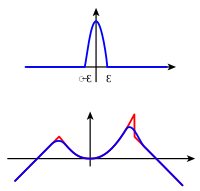Cutoff function

Imagine you have a very large cake that you want to cut into small pieces. But you only want to cut the parts of the cake that are in a certain area, like the middle part of the cake. So, you take a plastic cutter that has a curved edge and use it to only cut the cake where you want to. That plastic cutter is like a cutoff function in mathematics.
In math, a cutoff function is a way to limit a function's values to a specific area or range. It's like using a plastic cutter to only cut parts of the cake. The cutoff function is a tool that can be used to define a function so that it only "cuts" or "operates" in a specific range of values, while ignoring everything else.
For example, imagine we have a function that represents the temperature over time. We may only be interested in temperatures between certain values, for instance, between 60 and 90 degrees Fahrenheit. So, we can use a cutoff function to limit our original function so that it only considers temperatures between 60 and 90 degrees Fahrenheit. Anything below or above this range would be ignored or "cut off."
In simpler terms, a cutoff function is a tool that allows us to control what part of a function we want to focus on or study, by eliminating the irrelevant parts that we don't need.
In math, a cutoff function is a way to limit a function's values to a specific area or range. It's like using a plastic cutter to only cut parts of the cake. The cutoff function is a tool that can be used to define a function so that it only "cuts" or "operates" in a specific range of values, while ignoring everything else.
For example, imagine we have a function that represents the temperature over time. We may only be interested in temperatures between certain values, for instance, between 60 and 90 degrees Fahrenheit. So, we can use a cutoff function to limit our original function so that it only considers temperatures between 60 and 90 degrees Fahrenheit. Anything below or above this range would be ignored or "cut off."
In simpler terms, a cutoff function is a tool that allows us to control what part of a function we want to focus on or study, by eliminating the irrelevant parts that we don't need.
Related topics others have asked about:
